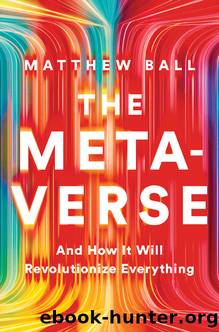The Metaverse by Unknown

Author:Unknown
Language: eng
Format: epub
Tags: Epub3
Publisher: Liveright
The 30% Standard
We might assume that the virtual world would have âbetterâ payment rails than the âreal world.â After all, its economy primarily involves goods that only exist virtually, and that are bought via purely digital (and thus low marginal cost) transactions, and are, for the most part, $5â$100 each. The virtual economy is also large. In 2021, consumers spent more than $50 billion on digital-only video games (in contrast to physical discs), and nearly $100 billion more on in-game goods, outfits, and extra lives. As a point of comparison, $40 billion was spent at the theatrical film box office in 2019, the last year before the COVID-19 pandemic, and $30 billion on recorded music. Whatâs more, the âGDPâ of the virtual world is growing rapidlyâit has quintupled on an inflation-adjusted basis since 2005. In theory, these facts should mean creativity, innovation, and competition in payments. In practice, the reverse has been true; the payment rails of todayâs virtual economy are more expensive, cumbersome, slow to change, and less competitive than those in the real world. Why? Because what we consider to be a virtual payment rail, such as PlayStationâs wallet, Appleâs Apple Pay, or in-app payment services, are really a stack of different âreal worldâ rails and forced bundle of many other services.
In 1983, the arcade manufacturer Namco approached Nintendo about publishing versions of its titles, such as Pac-Man, on its Nintendo Entertainment System (NES). At the time, the NES was not intended to be a platform. Instead, it played only titles made by Nintendo. Eventually, Namco agreed to pay Nintendo a 10% licensing fee on all of its titles that appeared for NES (Nintendo would have right of approval over every individual title), plus another 20% for Nintendo to manufacture Namcoâs game cartridges. This 30% fee ultimately became an industry standard, replicated by the likes of Atari, Sega, and PlayStation.2
Forty years later, few people play Pac-Man anymore, and costly cartridges have transformed into low-cost digital discs manufactured by game-makers and even lower-cost bandwidth for digital downloads (where the costs are mostly borne by consumers via internet fees and console hard drives). However, the 30% standard has endured and expanded to all in-game purchases, such as an extra life, digital backpack, premium pass, subscription, update, and more (this fee also covers the two to three percentage points charged by an underlying payment rail, such as PayPal or Visa).
Console platforms have several rationales for the fee beyond simply making money. The most important is how they enable game developers themselves to make money. For example, Sony and Microsoft typically sell their respective PlayStation and Xbox consoles for less than they cost to manufacture, which makes it cheaper for consumers to access powerful GPUs and CPUs, as well as other related hardware and components that are needed to play a game. And this per-unit loss is before these platforms allocate the research and development investments to design their consoles, marketing costs to convince users to buy them, and exclusive content (that
Download
This site does not store any files on its server. We only index and link to content provided by other sites. Please contact the content providers to delete copyright contents if any and email us, we'll remove relevant links or contents immediately.
Kathy Andrews Collection by Kathy Andrews(10521)
The remains of the day by Kazuo Ishiguro(7551)
Spare by Prince Harry The Duke of Sussex(4199)
Paper Towns by Green John(4169)
The Body: A Guide for Occupants by Bill Bryson(3802)
Be in a Treehouse by Pete Nelson(3214)
Harry Potter and the Goblet Of Fire by J.K. Rowling(3046)
Goodbye Paradise(2964)
Never by Ken Follett(2884)
Into Thin Air by Jon Krakauer(2703)
The Remains of the Day by Kazuo Ishiguro(2620)
The Genius of Japanese Carpentry by Azby Brown(2609)
The Cellar by Natasha Preston(2595)
Drawing Shortcuts: Developing Quick Drawing Skills Using Today's Technology by Leggitt Jim(2532)
120 Days of Sodom by Marquis de Sade(2439)
Architecture 101 by Nicole Bridge(2351)
The Man Who Died Twice by Richard Osman(2300)
Machine Learning at Scale with H2O by Gregory Keys | David Whiting(2293)
Fairy Tale by Stephen King(2071)
